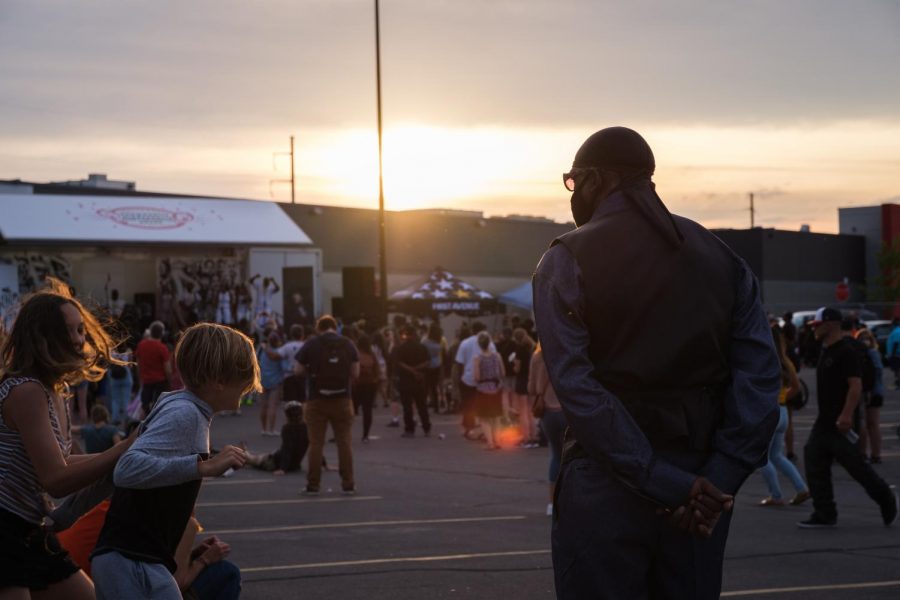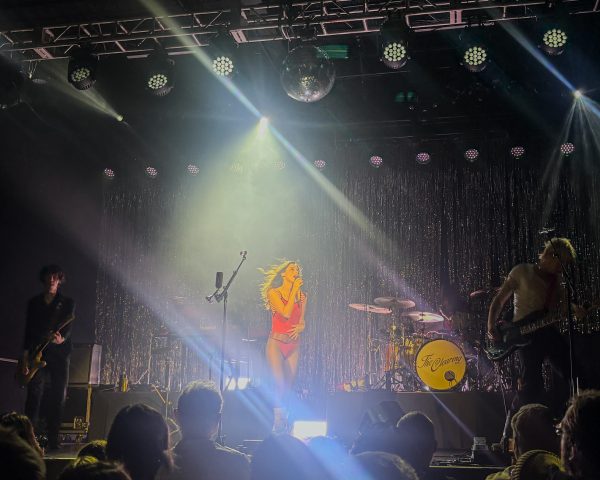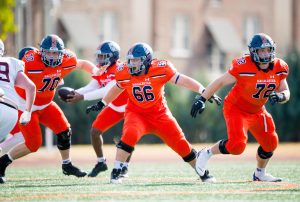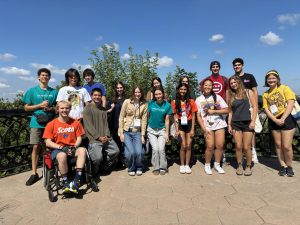Who will rebuild Minneapolis?
People from across the Twin Cities congregated at the corner of Lake and Minnehaha to celebrate Juneteenth. Photo bu Kori Suzuki ’21.
June 21, 2020
On Friday night, Juneteenth, people from across the Twin Cities descended on the intersection of Lake Street and Minnehaha Ave. to celebrate, commemorate and look toward the future.
It was here at this very intersection on the Thursday following the murder of George Floyd that thousands of protesters overran and set fire to the Minneapolis Police Department’s third precinct — a watershed moment in an uprising that was expanding across the country.
An Associated Press photograph of a protester carrying an upside-down American flag down Minnehaha Ave. past a blazing liquor store that night became one of the most iconic early images of the movement.
On Juneteenth, the liquor store ruins had become a magnet for amateur photographers. Many were greeted by a small bright blue sheet of paper stapled to a charred brick column on the Lake Street side of the building that read “Just browsing? Consider donating.”
A similar sign stapled to a sign pole on the Minnehaha Ave. side of the building read simply, “It’s Not Over” and included a link to Reclaim the Block’s list of organizations to donate to.
The signs spoke loudly. The fight for racial justice is not over by any stretch, and the effects of the uprising in the Twin Cities are still reverberating.
Nevertheless, Lake and Minnehaha on Friday night felt like uneven ground — full of people who participated in a paradigm-shifting event together now pursuing slightly divergent paths forward, trying to figure out how to shape the movement to rebuild the city.
On Friday night, the physical landscape, and the different events that spread across it, made that clear.
In a large Target parking lot, a group of organizations hosted an inaugural Juneteenth celebration complete with live music, food trucks, merchandise sales and a donation site. Some were there to raise money for the NAACP and Black Lives Matter. Others were there to support their businesses.
Just down Minnehaha Ave., in the lot next to Moon Palace Books, people joined winding lines stretching back to the street to get a graphic of the burning third precinct and the words “Welcome to Minneapolis” screen printed onto t-shirts.
Still other people, many of them carrying cameras, walked through the area marveling at and documenting the scores of buildings reduced to rubble in the aftermath of Floyd’s murder.
Each group of people, each event, had similar hopes but slightly different approaches — on everything from the police to corporations to where resources should be devoted.
The screen printing event, for instance, despite its location just feet from Lake Street, directed its fundraising elsewhere: raising money for a fund dedicated to rebuilding black-owned businesses in North Minneapolis.
“I live in South Minneapolis,” organizer Emma Crutcher said. “We’re going to bounce back. Obviously. In North Minneapolis, those are historic, black-owned businesses, historic buildings, and we should be raising money for them.”
Crutcher noted that a fund dedicated to rebuilding Lake Street has already raised in excess of $6 million — with considerable corporate support — and will begin to distribute grants soon. The North Minneapolis fundraising effort has been less successful.
“The North Minneapolis fund is currently right around $2 million — and I think it’s really unequal that the Lake Street fund has corporate donors and has raised so much more money when… all of the [Northside] businesses that were destroyed are local, Black-owned businesses,” Crutcher said.
The Juneteenth celebration down the block had a more diverse crowd, but a more corporate backdrop — one that drew skepticism from a number of passersby.
Target, which saw clashes and looting at its locations across the Twin Cities two weeks ago, hung a banner from its store just above the stage which read “We’ll stand together. And we’ll build together.”
James Everett, a former president of the Minneapolis NAACP and candidate for governor, helped to organize the celebration. He said that, despite Target’s ugly history in his home North Minneapolis, the sign’s presence did not bother him.
“Do I trust Target? Not necessarily,” he said. “Do I think that Target is a foundational piece of this? No. But, at the same time, I think they hit the bullseye with that sign.”
It wasn’t just the Target sign that courted controversy. The evening before, a heated debate erupted on the event’s Facebook page over the role that Minneapolis police officers were playing in training security for the event.
Everett said that while organizers did coordinate with the police department, the coordination was to ensure that there wouldn’t be any police presence on site. Community members would provide event security, police would provide backup.
“The coordination was making them aware that we would be doing our own thing,” he said. “But also that they’re on standby if we have to call. We have a community engagement officer that we can contact.
“If we want people to trust our leadership, we have to show examples of it,” he continued.
That was Everett’s take. It was not the equivalent of a shirt with the burning third precinct on it. But it was not completely divorced from it either.
Beverly Hammond, a government worker and resident of Maple Grove, Minn., was one of the people taking in the sights. She stopped at a colorful mural on the facade of The Hook and Ladder Theater & Lounge in between the Target lot and Moon Palace Books.
Hammond spent a portion of her childhood in Baltimore and was living there during the Freddie Gray protests in 2015. She said that these protests, this movement, felt more promising than that one.
“One thing I like about Minnesota is the coalition-ism,” she said. “We had pockets of that in Baltimore, but I think people tried to speak up and didn’t get heard… there wasn’t as much rallying and support from people other than Black people.”
That coalition-ism is going to be key going forward if the radicalism of the last several weeks is to hold and sustain itself.
Crutcher, observing the screen printing process, acknowledged that there has been a slowdown of mutual aid donations of late. But she remains confident about the movement’s ability to sustain itself in the coming months.
“I firmly believe that the people will have the ultimate control over rebuilding,” Crutcher said. “Minneapolis Parks becoming sanctuaries happened because… the people, us, put pressure on the city of Minneapolis [and] on the parks department.”
That pressure may not draw as many eyeballs now as it did several weeks ago. But it is having an impact.
“The rest of the country is not focused on what is happening in Minneapolis anymore,” Crutcher said. “They’re focused on what is happening in New York, and Atlanta and L.A., predominantly — which is good.
“But what people don’t see in other parts of the country is all of the mutual aid funds, all of the food hubs, all of the stuff that we have been doing that is completely grassroots in the city to support each other,” she continued. “And it’s not stopping. It’s not going to stop any time soon.
“For those of us who live here, we are going to be doing this for the rest of our lives.”














Dana Rotegard Mac 73 • Jun 22, 2020 at 3:33 pm
The Minneapolis Police Department has been an international embarrassment to my home city and law enforcement since my high school years in the 1960s. An old High School Classmate recently reminded me of an incident when the Head of the Police Federation, Chuck Stenvig brought his daughter along as spectators on one of many violent drug bust against “hippies” . I worked for Minneapolis in several capacities in the 1970’s. During that period Minneapolis was exempted from Minnesota civil rights laws and the Police Federation elected it’s chief mayor under its own rightist political movement “The Taxpayers Party”. The Police were literally a law unto themselves and unaccountable.
FBI statistics show that there has been and still is a huge racial disparity on police arrests and violence that is the worst in the USA (followed by Saint Paul and Detroit interestingly) Racially biased prosecution choices by the Hennepin county attorney predate the reign of Freeman or Klobuchar and interlock with the policing problem. MPIRG successfully sued the Police under Federal civil rights laws in the 70’s but ongoing attempts to reform the department by DFL Mayors Hofstede, Belton, Fraser, Rybeck and Frey have run up against the clout of the police federation and increasingly racist support from Republican allies in the legislature. From comments on this thread many here seem unaware that nearly all documented cases of arson and vandalism in South Minneapolis during recent troubles have come from provocateurs from the alt-right and out of town.
Trump and his ilk hate Minneapolis for the same reasons I love this town. Hopefully the urge to rebuild the city’s broken law enforcement will finally bear fruit.
Richard F Turnbull, J.D., Mac Alum • Jun 22, 2020 at 9:10 am
The good news about right wing extremists on here “explaining” that “if they were” active police officers, they would resign and “let anarchy reign” , since from a false premise, anything follows. The hypothetical is little but the usual guff these folks enjoy, it leads nowhere.
The rampant, hysterical, paranoid stereotyping of protesters at least serves to remind others just how wacky the Wingnut Weltanschauung can be, allowing us to keep up our guard, and understand we will have to persist in struggles to expand universal human rights against their obstruction, in the cases where they real do have any effect.
It is also important to acknowledge police officers who have publicly condemned what the police directly involved in the George Floyd homicide did, seek allies there when possible, and not stereotype every single Minneapolis cop as if they are of one mind on these issues.
Several dozen Minneapolis Police Department officers issued a strongly worded rebuke condemning the homicide, so in the midst of all the justifiable outrage it is worth remembering there are always splits and divides in the official police force, just as there are in the protest movement.
Sudo01 • Jun 22, 2020 at 7:51 am
I don’t think it will be the African American community…
Al Stiles • Jun 21, 2020 at 9:23 pm
It’s a bad situation as the people looting & burning have no idea what the real cost is. From a young age need to be taught about being responsible. The older citizens need to be given jobs and have employers pick them up and take them home if need be. The employer should be given a tax break and even be paid by government. Not saying the police don’t need some reform. They should try to figure a way to help instead of how many arrests they can make.
Sarah • Jun 21, 2020 at 8:38 pm
Taxpayers, of course. Like always. Those of us who work and are too busy to loot and destroy things. If these people actually had to work to repair these things then they wouldn’t do it. They are spoiled entitled who are used to others cleaning up their messes.
Jon • Jun 21, 2020 at 8:30 pm
MINNESOTA MANIACS….
LIVE IN THE SEWER YOU HAVE CREATED. NONE OF MY MONEY IS EVER GOING THERE.
Michael Brundage • Jun 21, 2020 at 7:13 pm
Minneapolis is a failed city. A bad cop murdered a felon and they burn down there city. If I worked for law enforcement I’d quit and let anarchy rein. Don’t waist tax dollars that these rioters don’t contribute too in rebuilding it. Let Anderson Cooper contribute some of his $100 million salary because Let CNN inflamed the situation. Black lives matters is.no better than the KKK they the protestors distract the police while there anarchist branch loots and burns down there own city..Maybe just maybe if these lazy people voted like good citizens then change would come but thensit home collecting food stamps and welfare checks.
JIM JEFFERS • Jun 21, 2020 at 5:39 pm
WHY BOTHER…AFTER LAST NIGHT IN UPTOWN..WHY REBUILD ANYTHING IN MINNEAPOLIS…
Max • Jun 21, 2020 at 4:23 pm
Cool way to miss the point, ancient internet tough guys. Police reform is long overdue in this city, and in this country. If a little unrest in your routine makes you say, “fine, f it, enjoy your nightmare, I don’t want to help any of you,” how can’t you see that normalized police brutality would create a MUCH larger stress response than weird, apathetic, internet snowflake fits?
If your fee-fees are valid at all, let me briefly and imaginarily introduce you to EVERYONE impacted by police violence. People can try to measure subjective experiences all day for the misery Olympics, but you’re gonna come up short if you’re mad about property damage and disrespect for symbols of state and power… and everyone else is mad about loss of life, disrespect for basic humanity, and inextricable economic fallout related to abuses of power.
People getting loud and justifiably angry about unequal policing and an uneven justice system makes sense. I think it’s great that the community is talking about what steps we take to go forward and be better, instead of scrambling to get “back to normal.” What we took for granted as normal was unacceptable. It hurt friends of mine, and took more from my family, than days of looting and a few weeks of tough headlines ever could. This unconstitutional crap was prevalent before, and it was gross that a lot of us were okay with it being normal, or found ways to rationalize it.
The people who showed up this Juneteenth amply demonstrated that they’re willing to start solving problems, not ignoring or excusing them because it’s “easy.” They’re getting interested and involved in the politics that govern their lives more than ever. What else is supposed to be more beautiful in America?
Barbara J McSpadden • Jun 21, 2020 at 3:09 pm
So they wanted to provide their own security with police back up if needed….any one else see the hypocrisy here?…
Richard F Turnbull, J.D., Mac Alum • Jun 21, 2020 at 2:14 pm
Hyperbolic comparisons between Minneapolis and Baltimore aside, the entirely justified protests against heinous police misconduct were tarnished by a fringe element, some of whom engaged in mindless property damage and worse, in some cases posing a serious threat to human life, such as the alleged arsonists.
No one is attempting to claim that behavior — on the part of a tiny fraction of the many thousands of peaceful protesters —was legally or morally justified. Even their defense attorneys are not going to insult the court by taking that line!
If crimes were committed and are sustained as such in the judicial process, just as the police must be held accountable, so must those few who exploited a valid cause to wreak havoc.
But let’s not lose sight of the unconscionable acts that took the life of George Floyd, or other black Americans in equally despicable ways, by those entrusted by society to serve and protect us.
The changes needed in our policing are decades, if not centuries, overdue.
Right wingers seeking to smear the entire protest movement, on the basis of a fringe element of violent individuals, are pathetic indeed.
Drew g • Jun 21, 2020 at 11:31 am
All you’ll end up with is vacant buildings, drug addicts, homelessness, and prostitution, all walking trying to avoid needles and human feces. It’s been that way in every other city and Minneapolis will be no exception. The parks are being overtaken by those who contribute nothing, and pushing out those who used to use them for pleasure. Taxpayers and businesses will all move out. Good luck. Baltimore in Minneapolis is a coming. Enjoy, that’s what you want, that’s what you get.
Chris • Jun 21, 2020 at 9:05 am
I’ve been building and rebuilding this city since the day I started paying taxes almost 20 years ago. I’m not doing it again. They are on their own in this one.